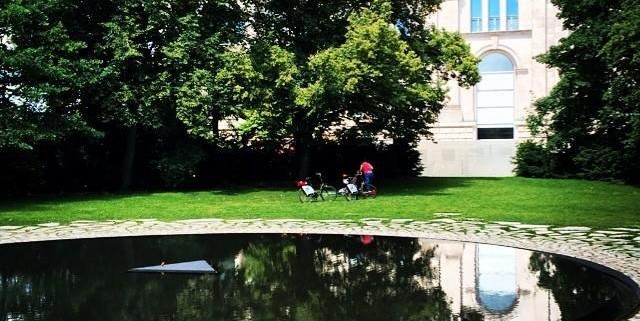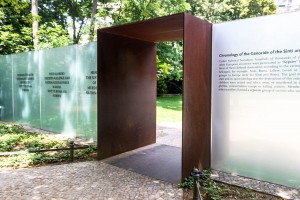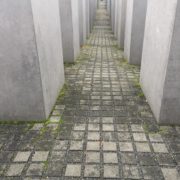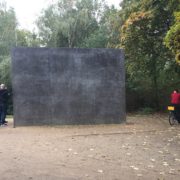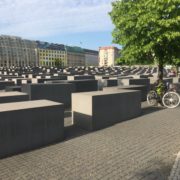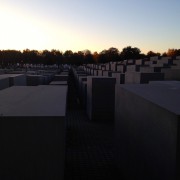Memorial to the Sinti and Roma Victims of National Socialism
Often times, when the word “Holocaust” is mentioned we only think of one group of people, the Jews. There were several other minority groups that suffered through a tragic genocide as well during World War II. The Sinti and the Roma people, also known as “Gypsies” have long faced persecution in Europe. The peak of this persecution was the Porajmos, the attempt made by Nazi Germany to exterminate the Gypsies of Europe during World War II. Roma (Gypsies) are a diasporic ethnicity originated in the Punjab region of India. They first came to Europe between the eighth and tenth centuries. Since then, they have suffered economic, political and cultural discrimination. It is believed that they have been called “Gypsies” as Europeans mistakenly believed they came from Egypt. The Roma people are considered the largest ethnic minority in Eastern Europe.
As was the case with European Jews, Hitler defined the Sinti and Roma people as “enemies of the race-based state”. Up to 500,000 Sinti and Roma people were murdered under the Nazi rule, a number that is high but yet not well known by the average person. Although it is unclear as to how many were ultimately murdered during the Porajmos, the German government didn’t even officially recognize the genocide until 1982.
The Sinti and Roma Memorial was built by Dani Karavan in October 2012, situated near the Reichstag where the German Parliament meets. The memorial is an extremely calm and serene place to be. It features a round reflection pool in the center, with a triangular platform holding a single flower. This flower is replaced every single day, a reminder for us never to forget. The triangle is a representation of the symbol the Sinti and Roma people were forced to wear as identification in the concentration camps. Broken pieces of stone can be found around the grounds of the memorial. A faint song can be heard in the background, while the words to “Auschwitz” by Italian Roma author Santino Spinello can be seen inscribed around the edge of the monument: “Sunken in face, extinguished eyes, cold lips, silence, a torn heart, without breath, without words, no tears”.
One student, Abbey Gordon, recalls on her past experience with the Roma people:
“This memorial had touched me personally in many ways. I studied abroad in Italy for a semester and often saw Roma people on the street. I was told by all my professors to stay away from the ‘Gypsies,’ as most of them were seeking money from tourists constantly. Every single day I would encounter Gypsies who asked me for money and cursed me when I didn’t give them any. I became annoyed by them and would go out of my way to avoid seeing them on the streets. At that time I didn’t exactly know who Gypsies were or where they came from, and I definitely did not know that they had suffered genocide during World War II. Most American students don’t know about the recent history of the Roma people. If I had known about their suffering I would have looked at them with a warmer heart. When I visited this memorial, I felt ashamed of myself for looking down on the Roma people in Italy. I had no idea of the vast suffering they faced in the past, or that they still face persecution in Europe.”
The Sinti and Roma still face discrimination even today; sadly, an example of this discrimination is presented at this memorial. As beautiful of a memorial as this is, the Sinti and Roma still face exclusion. Even though this is a memorial commemorating them, they still have to worry about regulations being placed on them regarding their culture of begging. The faint music that you hear is indeed played by them but they are only allowed a maximum of two Roma and Sinti outside of the vicinity of the memorial to ask for money. Asking for money, or begging, is a major part of their culture and also their past. This takes away from the experience of the memorial since it is difficult to imagine the feeling of not being allowed to participate in an active part of their lives while at a memorial for people of your culture.
If you are at the memorial unaware of this rule hearing the beautiful music, chances are you will think it is a beautiful memorial; learning about this exclusionary rule changes this experience. As students initially visiting this memorial, we were struck by its peaceful and relaxing atmosphere. Seeing people enjoying this memorial reinforced our initial impression. Once we learnt of the fate of the Roma and the rules of the memorial, we had mixed feelings. Our eyes were opened to the discrimination that they still sadly face today. The Sinti and Roma may have a beautiful memorial commemorating the tragedy of World War II, but there is irony in them not being allowed to fully participate in commemorating their own history. This contradiction solidified our awareness that the Roma and Sinti are still being persecuted today.
By Abbey Gordon, Allison Kisielis, Hadeel Al Haddadeh

